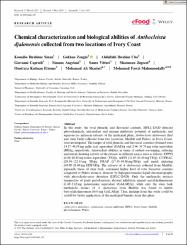Chemical characterization and biological abilities of Anthocleista djalonensis collected from two locations of Ivory Coast

View/
Access
info:eu-repo/semantics/openAccessDate
2023Author
Sinan, Kouadio IbrahimeZengin, Gokhan
Uba, Abdullahi Ibrahim
Caprioli, Giovanni
Angeloni, Simone
Vittori, Sauro
Jugreet, Sharmeen
Etienne, Ouattara Katinan
Shariati, Mohamad Ali
Mahomoodally, Mohamad Fawzi
Metadata
Show full item recordCitation
Sinan, K. I., Zengin, G., Uba, A. I., Caprioli, G., Angeloni, S., Vittori, S., ... & Mahomoodally, M. F. (2023). Chemical characterization and biological abilities of Anthocleista djalonensis collected from two locations of Ivory Coast. eFood, 4(4), e100.Abstract
In this study, the total phenolic and flavonoid contents, HPLC-DAD detected phytochemicals, antioxidant and enzyme inhibitory potential of methanolic and aqueous (as infusion) extracts of the medicinal plant, Anthocleista djalonensis (leaf and stem bark) collected from two locations, Mafiblé and Prikro, in Ivory Coast, were investigated. The ranges of total phenolic and flavonoid contents obtained were 14.17–46.95 mg gallic acid equivalent (GAE)/g and 2.96–34.76 mg rutin equivalent (RE)/g, respectively. Antioxidant abilities in terms of radical scavenging, reducing and metal chelating activity of the extracts in different assays were as follows: DPPH (4.90–48.82 mg trolox equivalent [TE]/g), ABTS (21.05–81.89 mg TE/g), CUPRAC (29.54–122.33 mg TE/g), FRAP (17.53–94.06 mg TE/g) and metal chelating (10.09–28.49 mg EDTAE/g. The extracts of A. djalonensis collected from Mafiblé, especially those of stem bark, contained higher level of total bioactive contents compared to Prikro extracts, detected by high-performance liquid chromatography with photodiode-array detection (HPLC-DAD). Only the methanolic extracts irrespective of plant parts/location, showed inhibition against acetylcholinesterase (1.42–2.12 mg galantamine equivalent (GALAE)/g), while only the stem bark methanolic extract of A. djalonensis from Mafiblé was found to inhibit butyrylcholinesterase (0.65 mg GALAE/g). Thus, findings from this study could be useful for better application of the medicinal benefits from this plant. © 2023 The Authors. eFood published by John Wiley & Sons Australia, Ltd on behalf of International Association of Dietetic Nutrition and Safety.

















